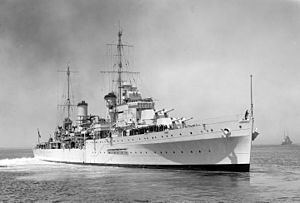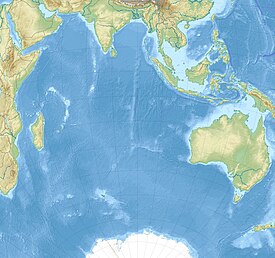
Back معركة الطراد المساعد كورموران والطراد سيدني Arabic Kormoran və Sidney HMAS kreyserləri arasında dəniz döyüşü Azerbaijani Bataille entre le Sydney et le Kormoran French Pertempuran antara HMAS Sydney dan HSK Kormoran Malay Bitwa HMAS Sydney z HSK Kormoran Polish Бой между «Сиднеем» и «Кормораном» Russian Bitka između Sydneyja i Kormorana Serbo-Croatian
| Sydney–Kormoran action | |||||
|---|---|---|---|---|---|
| Part of the Indian Ocean Theatre of World War II | |||||
Light cruiser HMAS Sydney (top) and auxiliary cruiser Kormoran (bottom) (both in 1940) | |||||
| |||||
| Belligerents | |||||
|
|
| ||||
| Commanders and leaders | |||||
|
|
| ||||
| Strength | |||||
| Auxiliary cruiser Kormoran | Light cruiser Sydney | ||||
| Casualties and losses | |||||
|
82 killed Kormoran scuttled |
645 killed Sydney sunk | ||||
Location within Indian Ocean | |||||
On 19 November 1941, the Australian light cruiser HMAS Sydney and the German auxiliary cruiser Kormoran engaged each other in a battle off the coast of Western Australia. Sydney, with Captain Joseph Burnett commanding, and Kormoran, under Fregattenkapitän Theodor Detmers, encountered each other approximately 106 nautical miles (196 km; 122 mi) off Dirk Hartog Island. The single-ship action lasted half an hour, and both ships were destroyed.
From 24 November, after Sydney failed to return to port, air and sea searches were conducted. Boats and rafts carrying survivors from Kormoran were recovered at sea, while others made landfall at Quobba Station, 60 km (37 mi) north of Carnarvon; 318 of the 399 personnel on Kormoran survived. While debris from Sydney was found, there were no survivors from the 645-strong complement. It was the largest loss of life in the history of the Royal Australian Navy, the largest Allied warship lost with all hands during World War II, and a major blow to Australian wartime morale.[1] Australian authorities learned of Sydney's fate from the surviving Kormoran personnel, who were held in prisoner of war camps until the end of the war.
Controversy has often surrounded the battle, especially in the years before the two wrecks were located in 2008. How and why a purpose-built warship such as Sydney was defeated by a modified merchant vessel such as Kormoran was the subject of speculation, with numerous books on the subject, as well as two official reports by government inquiries, published in 1999 and 2009.
According to German accounts—which were assessed as truthful and generally accurate by Australian interrogators during the war, as well as most subsequent analyses—Sydney approached so close to Kormoran that the Australian cruiser lost the advantages of heavier armour and superior gun range. Nevertheless, several post-war publications have alleged that Sydney's loss had been the subject of an extensive cover-up, that the Germans had not followed the laws of war, that Australian survivors were massacred following the battle, or that the Empire of Japan had been secretly involved in the action (before officially declaring war in December). Currently no evidence supports any of these theories.
- ^ Jeans, Seafaring Lore and Legend, pp. 189–191
© MMXXIII Rich X Search. We shall prevail. All rights reserved. Rich X Search


